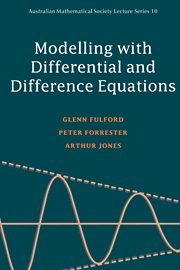Book contents
- Frontmatter
- Contents
- Preface
- Introduction to the student
- Part One Simple Models in Mechanics
- Part Two Models with Difference Equations
- Part Three Models with Differential Equations
- 11 Continuous growth and decay models
- 12 Modelling heat flow
- 13 Compartment models of mixing
- Part Four Further Mechanics
- Part Five Coupled Models
- References
- Index
12 - Modelling heat flow
Published online by Cambridge University Press: 05 June 2012
- Frontmatter
- Contents
- Preface
- Introduction to the student
- Part One Simple Models in Mechanics
- Part Two Models with Difference Equations
- Part Three Models with Differential Equations
- 11 Continuous growth and decay models
- 12 Modelling heat flow
- 13 Compartment models of mixing
- Part Four Further Mechanics
- Part Five Coupled Models
- References
- Index
Summary
Some typical processes from everyday life which involve the flow of heat from one region to another are the heating of beverages, food and living areas, and the cooling of foodstuffs in refrigerators. The flow of heat involved in such processes is best described by mathematical models. This chapter introduces some simple mathematical models which are based on Newton's law of cooling and Fourier's law of heat conduction. These laws lead to very simple differential equations of the type studied in Chapter 11. At the end of this chapter these ideas are used to model the loss of heat from an insulated water pipe. The model makes some unexpected predictions.
The only concept from physics which is assumed initially is that of temperature – which indicates the hotness of a body, and is measured with a thermometer.
Newton's model of heating and cooling
A hot cup of coffee, when left standing for a while, cools as heat is lost to the surrounding air. The temperature of the coffee drops and, if the coffee is left standing for long enough, its temperature eventually reaches that of its surroundings. This example is typical of many processes involving cooling, and heating, which occur in a wide variety of situations. Fortunately there is a very simple mathematical model for such problems, due to Newton., which is both reliable and versatile.
In this section the simplest version of Newton's model is described, which uses only the concept of temperature.
- Type
- Chapter
- Information
- Modelling with Differential and Difference Equations , pp. 232 - 256Publisher: Cambridge University PressPrint publication year: 1997

